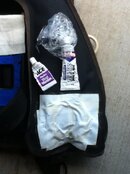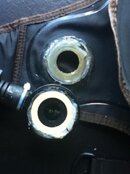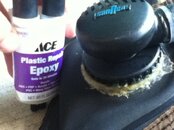tmcfarla
New
I bought a used BC from my local shop a while back, they claimed it was "re-serviced," but it broke almost immediately afterwards. They wouldn't accept a return and I didn't have money to buy another one, so I did my best to repair it. It has worked out pretty well after about 20 dives, so I'll relate my experiences here.
The male threading on the BC where the inflation hose and the dump valve screw onto the BC were both really rotten, one failed the first dive, the other failed the third dive. You can buy a replacement male threading online, but it is a total rip-off (over $100; expensive enough that it simply doesn't make sense to not buy a new BC if you are going to try to repair with that route). It is a seaquest balance BC, and I have read similar accounts of threading falling apart from other owners of seaquest BCs. My next BC will not be a seaquest.
Disclaimer!
I dive in conditions where a BC is a convenience more than a life saving device (close to shore in relatively calm tropical water, with a buoyant wetsuit, always with a buddy, and one of us will be carrying a safety sausage). If you aren't fully confident in your ability to repair things, or if you ever dive in conditions where a BC is really important for safety (open ocean, tech diving, drysuit diving, solo diving, etc.) think long and hard before attempting a similar repair (or better yet, don't think and just buy a new BC).
The dump valve.
I ended up just cutting the entire dump valve out and patching the hole. I couldn't really reach the back dump valve to begin with so it probably doesn't matter. I used two layers of vinyl attached to the inside of the bladder (vinyl to vinyl, not vinyl to dacron), using Loktite stic n' seal (a flexible adhesive that is applied to both surfaces and allowed to partially dry before the surfaces are pressed together) then covered the entire thing with dacron sail repair tape for durability and to protect against punctures. I glued the edges of the sail repair tape down with aquaseal so it wouldn't curl up over time. This has lasted about 20 dives without any apparent wear. I have stress tesed it by over-inflating the BC and trying to squeeze air out, I am pretty sure this patch is the most durable area on the entire BC. It doesn't fold all that well, but it seems to hold. The hole this repaired was about 4 inches across and right near a fold on the BC and it seems to work very well, so I think this is a good method for repairing any large rips and holes in a BC. Most people look at this and assume I just duck-taped my BC together and assume I am crazy, this is the only real downside to this repair. Note: you can buy large dacron patches, but they didn't seem to stay on well, probably because there are too many creases for a patch that size to conform to. Numerous, small pieces of sail repair tape seems to work better (and the sail repair tape might have a slightly better adhesive as well). Picture of the final repair:

The inflation hose.
Since I couldn't just patch over the inflation hose valve, I first used loktite stik n' seal to glue the pieces of the male threads back together, basically just repairing it piece by piece. With this, the hose was still removable by unscrewing. This was never perfectly air tight: at the end of the first dives there were several tablespoons of water in my BC, by the 15th dive it was probably more than a cup of water. At that point I pulled it apart and it came apart quite easily. Picture of what this looked like after I pulled the first repair apart after about 15 dives:

For the second attempt, I used plastic repair epoxy from ace hardware (avoid 5 minute epoxies in general, and it is probably better to use epoxy specially designed for plastics) to glue the threads back together and to glue the hose attachment to the threads. I put a large bead of epoxy on the threads, placed the broken pieces where they belonged, and screwed the hose assembly on, after 24 hours of curing, I put another bead of epoxy around the base for extra strength. The epoxy basically goes all the way from the threads to the twisting plastic base of the hose assembly. The hose it no longer removable but it seems really solid. Note: make sure you don't glue the two inside sides of the bladder together, I put a piece of saran rap on the inside of the bladder to prevent this from happening. I expected the epoxy would be strong but not air-tight and was prepared to add aqua-seal around the edge, but this doesn't seem to be necessary. Picture of the final epoxy repair, you can only see the outside bead of epoxy, but all of the threading was covered as well:
Conclusions:
Vinyl patches and dacron sail repair tape seem to be able to patch just about any hole you'll ever find on a BC and it seems to be holding up very well. Don't throw away a BC because of a tear, even a large one.
Threading is trickier, if you need to repair threading, I recommend just using epoxy to attach the hose assembly or dump valve to the BC by whatever threads are still there and accept that you won't be able to remove it again (keep all pieces and epoxy those in at well). Depending on the severity of the rotten threading, you may have to build it up a bit before you can epoxy the hose assembly to it. Most people aren't as cheap as I am, aren't as reckless as I am, and don't enjoy fixing things as much as I do, so I expect most won't ever try this (and honestly, if I could afford another BC, I might not either). But it seems to be ok, certainly as a temporary fix. Right now, my BC is entirely air-tight, even when I inflate it and press hard on it, after dives, I find no water or almost no water in the BC. I'll update this if I run into problems with the epoxy in the future, but at very least this seems like a valid emergency fix, if not a permanent one.
The male threading on the BC where the inflation hose and the dump valve screw onto the BC were both really rotten, one failed the first dive, the other failed the third dive. You can buy a replacement male threading online, but it is a total rip-off (over $100; expensive enough that it simply doesn't make sense to not buy a new BC if you are going to try to repair with that route). It is a seaquest balance BC, and I have read similar accounts of threading falling apart from other owners of seaquest BCs. My next BC will not be a seaquest.
Disclaimer!
I dive in conditions where a BC is a convenience more than a life saving device (close to shore in relatively calm tropical water, with a buoyant wetsuit, always with a buddy, and one of us will be carrying a safety sausage). If you aren't fully confident in your ability to repair things, or if you ever dive in conditions where a BC is really important for safety (open ocean, tech diving, drysuit diving, solo diving, etc.) think long and hard before attempting a similar repair (or better yet, don't think and just buy a new BC).
The dump valve.
I ended up just cutting the entire dump valve out and patching the hole. I couldn't really reach the back dump valve to begin with so it probably doesn't matter. I used two layers of vinyl attached to the inside of the bladder (vinyl to vinyl, not vinyl to dacron), using Loktite stic n' seal (a flexible adhesive that is applied to both surfaces and allowed to partially dry before the surfaces are pressed together) then covered the entire thing with dacron sail repair tape for durability and to protect against punctures. I glued the edges of the sail repair tape down with aquaseal so it wouldn't curl up over time. This has lasted about 20 dives without any apparent wear. I have stress tesed it by over-inflating the BC and trying to squeeze air out, I am pretty sure this patch is the most durable area on the entire BC. It doesn't fold all that well, but it seems to hold. The hole this repaired was about 4 inches across and right near a fold on the BC and it seems to work very well, so I think this is a good method for repairing any large rips and holes in a BC. Most people look at this and assume I just duck-taped my BC together and assume I am crazy, this is the only real downside to this repair. Note: you can buy large dacron patches, but they didn't seem to stay on well, probably because there are too many creases for a patch that size to conform to. Numerous, small pieces of sail repair tape seems to work better (and the sail repair tape might have a slightly better adhesive as well). Picture of the final repair:

The inflation hose.
Since I couldn't just patch over the inflation hose valve, I first used loktite stik n' seal to glue the pieces of the male threads back together, basically just repairing it piece by piece. With this, the hose was still removable by unscrewing. This was never perfectly air tight: at the end of the first dives there were several tablespoons of water in my BC, by the 15th dive it was probably more than a cup of water. At that point I pulled it apart and it came apart quite easily. Picture of what this looked like after I pulled the first repair apart after about 15 dives:

For the second attempt, I used plastic repair epoxy from ace hardware (avoid 5 minute epoxies in general, and it is probably better to use epoxy specially designed for plastics) to glue the threads back together and to glue the hose attachment to the threads. I put a large bead of epoxy on the threads, placed the broken pieces where they belonged, and screwed the hose assembly on, after 24 hours of curing, I put another bead of epoxy around the base for extra strength. The epoxy basically goes all the way from the threads to the twisting plastic base of the hose assembly. The hose it no longer removable but it seems really solid. Note: make sure you don't glue the two inside sides of the bladder together, I put a piece of saran rap on the inside of the bladder to prevent this from happening. I expected the epoxy would be strong but not air-tight and was prepared to add aqua-seal around the edge, but this doesn't seem to be necessary. Picture of the final epoxy repair, you can only see the outside bead of epoxy, but all of the threading was covered as well:

Conclusions:
Vinyl patches and dacron sail repair tape seem to be able to patch just about any hole you'll ever find on a BC and it seems to be holding up very well. Don't throw away a BC because of a tear, even a large one.
Threading is trickier, if you need to repair threading, I recommend just using epoxy to attach the hose assembly or dump valve to the BC by whatever threads are still there and accept that you won't be able to remove it again (keep all pieces and epoxy those in at well). Depending on the severity of the rotten threading, you may have to build it up a bit before you can epoxy the hose assembly to it. Most people aren't as cheap as I am, aren't as reckless as I am, and don't enjoy fixing things as much as I do, so I expect most won't ever try this (and honestly, if I could afford another BC, I might not either). But it seems to be ok, certainly as a temporary fix. Right now, my BC is entirely air-tight, even when I inflate it and press hard on it, after dives, I find no water or almost no water in the BC. I'll update this if I run into problems with the epoxy in the future, but at very least this seems like a valid emergency fix, if not a permanent one.



